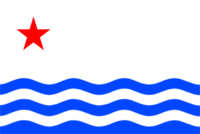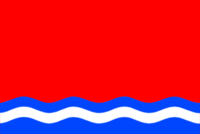Maremedres Free State
The Maremedres Free State (Gerenian: Stät Kestes Maremedre'es) was a republic established in Maremedres on 5 December 2013, and disbanded 22 days later, during the anarchy period in Gerenia.
History
- See also: December Anarchy
The Communist Party of Maremedres (CPM) was founded in Mergeazes in March 2013 by a group of workers and students who distrusted the government of the Independent Party of Gerenia. They proposed themselves as main goal to install a Communist government in the province, and later in the whole country. However, many of the founders of the party thought that Maremedres should be independent, and emphasised all sorts of differences between Maremedres and the rest of Gerenia, from climate to dialects spoken.
The CPM received a great boost when Governor Eužine Savada joined them. The national government began planning a prosecution campaign, as the Communists were seen as a threat to stability. The prosecution intensified after the CPM won the 2013 provincial election. Elie Harday, the Party's leader, was disallowed to take office, and had to leave the country as the national government appointed Konstantîn Vatrîn as provisional Governor. These events gained the independence advocates many supporters, and resulted in the formation of the Revolutionary Communist Movement (RCM) --the CPM's militant branch.
At the end of the year, with the leave of President Gerald Ruze, the CPM and the RCM saw an opportunity to establish an independent state. In 5 December, Governor Heraiz was deposed, and the Maremedres Free State subsequently founded. One week later, both the CPM and the RCM controlled the Northern Sea coast, which included the cities of Mergeazes, Modasan and Sargaflus. Nevertheless, the movement lacked on strength. The Free State leaders, as well as the population, were divided between those who wanted full independence, and those who wanted the Free State to become a successor state to Gerenia. The latter saw necessary to take the national capital, Nevaya, in order to take over the whole country. Their ideas were rejected by the supporters of independence, and thus the movement was almost fractured.
Meanwhile, the 2nd Regiment of the Gerenian Army, incited by the prospective return of President Ruze, started a military campaign to defeat the Free State. A force of 4,000 troops left their base in Selä and marched towards the coast. A small fraction of the force reached Modasan in 22 December, and retook the town without fighting. The bulk of the pro-Gerenian forces, by their part, continued towards Mergeazes, where they fought the RCM for two days. At the same time, a second pro-Gerenian force formed by the 5th Regiment entered in Maremedres from Clements, and joined the personnel at the Air Force base in Nueva Junín to later march to Sargaflus, where they met little resistence.
In 25 December, the RCM surrendered to the pro-Gerenians. During the following days, several CPM leaders tried to engage in negotiations with the pro-Gerenians, but it was in vain, and the CPM announced the disestablishment of the Free State in 27 December.
Flag
The Free State did not have official symbols, although two flags were commonly used, each with their own variations. One of the flags was similar to the Maremedres' provincial flag, with the blue lower half and the white wavy stripes, but with the upper half being white. The flag raised at the Provincial Government House also had a red star in the upper left. Other versions had the star in the centre, and others had two or three stars in the upper half. The other flag was mainly used by the RCM, and consisted on a red stripe that took the top 5/6 of the flag, and a lower, blue stripe that took the remaining space. Between both, there were two wavy stripes of blue and white. Either white or golden stars were usually added to the flag.

